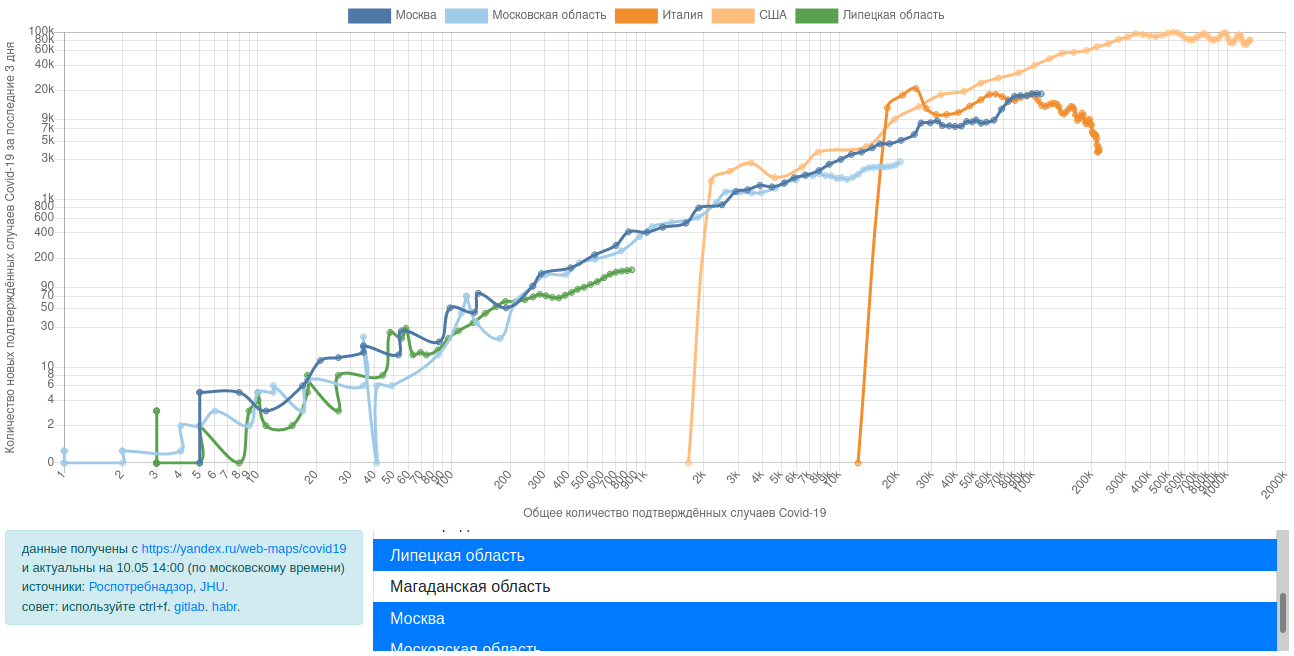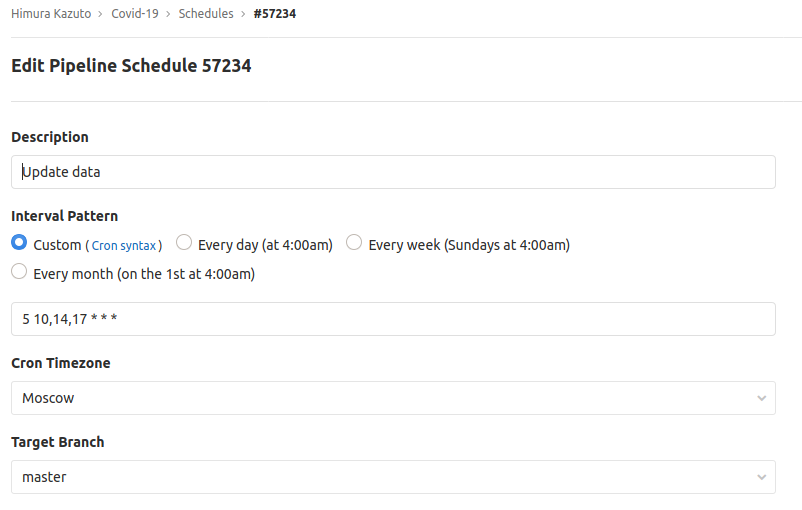In times of widespread obsession with libraries and web frameworks, we began to forget the joy of solving problems with minimal means. In this article, we will zapillit a web service on a relevant topic using vanilla Python and JavaScript, and also install it in GitLab Pages . Fast, minimalistic, without unnecessary dependencies, and as elegant as possible.
Inspired vidosy How To Tell If We're Beating COVID - 19 from minutephysics , I sketched in the free (from teleworking and home affairs) time service that is based on data from Maps coronavirus spread in Russia and in the world of Yandex builds graphs, similar to those on the Covid Trends page . Here is what came of it:

Interesting? Let's go!
Where to get the data?
Around the time when I had the idea to reproduce graphs from minutephysics for the Russian regions, Yandex added histograms for each region to the map.

, . - , , , , requests . , ( , , , ):
from urllib.request import urlopen
from html.parser import HTMLParser
import json
class Covid19DataLoader(HTMLParser):
page_url = "https://yandex.ru/web-maps/covid19"
def __init__(self):
super().__init__()
self.config_found = False
self.config = None
def load(self):
with urlopen(self.page_url) as response:
page = response.read().decode("utf8")
self.feed(page)
return self.config['covidData']
def handle_starttag(self, tag, attrs):
if tag == 'script':
for k, v in attrs:
if k == 'class' and v == 'config-view':
self.config_found = True
def handle_data(self, data):
if self.config_found and not self.config:
self.config = json.loads(data)
?
, — HTML-, Chart.js. - , string.Template:
def get_html(covid_data):
template_str = open(page_path, 'r', encoding='utf-8').read()
template = Template(template_str)
page = template.substitute(
covid_data=json.dumps(covid_data),
data_info=get_info(covid_data)
)
return page
page_path :
<!DOCTYPE html>
<html>
<head></head>
<body>
<div>$data_info</div>
<script type="text/javascript">
let covid_data = $covid_data
</script>
</body>
</html>
! ! !
?
. Python:
from http.server import BaseHTTPRequestHandler
from lib.data_loader import Covid19DataLoader
from lib.page_maker import get_html
class Handler(BaseHTTPRequestHandler):
def do_GET(self):
if self.path == '/':
self.send_response(200)
self.send_header('Content-Type', 'text/html')
self.end_headers()
try:
response = get_html(Covid19DataLoader().load())
self.wfile.write(response.encode('utf-8'))
except Exception as e:
self.send_error(500)
print(f'{type(e).__name__}: {e}')
else:
self.send_error(404)
, GitLab Pages,
, , , .
: . (, cron). , !
, 3 , . " ?" , , , - ( ) , !
from datetime import timedelta
from functools import reduce
y_axis_window = timedelta(days=3).total_seconds()
def get_cases_in_window(data, current_time):
window_open_time = current_time - y_axis_window
cases_in_window = list(filter(lambda s: window_open_time <= s['ts'] < current_time, data))
return cases_in_window
def differentiate(data):
result = [data[0]]
for prev_i, cur_sample in enumerate(data[1:]):
result.append({
'ts': cur_sample['ts'],
'value': cur_sample['value'] - data[prev_i]['value']
})
return result
def get_trend(histogram):
trend = []
new_cases = differentiate(histogram)
for sample in histogram:
current_time = sample['ts']
total_cases = sample['value']
new_cases_in_window = get_cases_in_window(new_cases, current_time)
total_new_cases_in_window = reduce(lambda a, c: a + c['value'], new_cases_in_window, 0)
trend.append({'x': total_cases,'y': total_new_cases_in_window})
return trend
def get_trends(data_items):
return { area['name']: get_trend(area['histogram']) for area in data_items }
, ( CSS Grid, ), . , - . .
?
Docker, , — VPS, docker-compose up --build -d, cron - ( , ?? , ...), , , http.server , . GitLab CI ssh ( ).
, , , .
GitLab Pages:
import os
from lib.data_loader import Covid19DataLoader
from lib.data_processor import get_trends
from lib.page_maker import get_html
page_dir = 'public'
page_name = 'index.html'
print('Updating Covid-19 data from Yandex...')
raw_data = Covid19DataLoader().load()
print('Calculating trends...')
trends = get_trends(raw_data['items'])
page = get_html({'raw_data': raw_data, 'trends': trends})
if not os.path.isdir(page_dir):
os.mkdir(page_dir)
page_path = os.path.join(page_dir, page_name)
open(page_path, 'w', encoding='utf-8').write(page)
print(f'Page saved as "{page_path}"')
, https://himura.gitlab.io/covid19, .gitlab-ci.yml:
image: python
pages:
stage: deploy
only: [ master ]
script:
- python ./get_static_html.py
artifacts:
paths: [ public ]
Pipeline Schedules:

- :

— :

?
, GitLab: https://gitlab.com/himura/covid19
, , 2 . , - MVP, , - . , , — . known issues:
I hope the article was interesting and / or useful, and I also really hope that soon we will all see how the lines of the graphs rush down.
Be healthy and do not add dependencies to your code that you can do without!